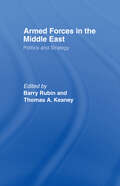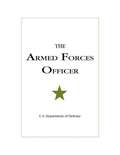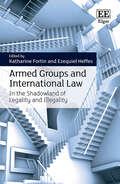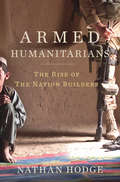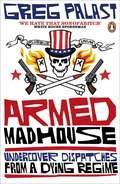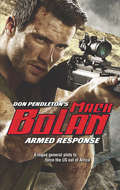- Table View
- List View
Armed Forces in the Middle East: Politics and Strategy (Besa Studies In International Security)
by Barry Rubin Thomas A. KeaneyAn examination of the Middle East's leading armed forces and their role in both military and political affairs. The book considers their missions, doctrine, training, equipment and effectiveness as fighting forces.
The Armed Forces Officer
by U.S. Department of DefenseThis edition is a classic series of books of the same title. These books have provided a foundation of thought, conduct, standards, and duty for American commissioned officers. Available now to the general public, this new edition takes the series inspirational premise into the new century. It educates officers of all services, as well as civilians, about the fundamental moral-ethical requirements of being a commissioned officer in the armed forces of the United States.
Armed Forces, Soldiers and Civil-Military Relations: Essays in Honor of Jürgen Kuhlmann (Schriftenreihe des Sozialwissenschaftlichen Instituts der Bundeswehr)
by Gerhard Kümmel Giuseppe Caforio Christopher DandekerIt is an honor for us to introduce this collection of essays, which is dedicated to an old friend and colleague who is no longer with us. It is an honor, but also a pleasure because we feel like continuing a dialogue with Jürgen; one that has never broken down over the years, revisiting and recalling the diff- ent places and occasions where we met, discussed, collaborated and had fun. We, that is, Giuseppe Caforio, Christopher Dandeker and Gerhard Kümmel who have been friends and/or colleagues of and research collaborators with Jürgen and who represent three prominent institutions and organizations with which Jürgen worked, felt that this book is something we owe to Jürgen and we are grateful that many people who at different times and at different places had contact with Jürgen and his work were willing to contribute a chapter to this anthology. Most of Jürgen’s studies, professional work and research activities took place at the Bundeswehr Institute of Social Sciences (SOWI). Jürgen, born in 1938, had joined the Bundeswehr in 1957 and had already worked at the SOWI’s predecessor institution, the Scientific Institute for Education in the Armed Forces from 1971 onwards after having finished his university? st- ies. Since this institute was renamed SOWI in 1974, Jürgen belonged to the first generation of researchers that worked at the SOWI.
The Armed Forces: Towards a Post-Interventionist Era? (Schriftenreihe des Zentrums für Militärgeschichte und Sozialwissenschaften der Bundeswehr #14)
by Gerhard Kümmel Bastian GiegerichThe present anthology stems from the perception of a widespread and manifest uneasiness concerning the business of military intervention in our times. Indeed, the West is for quite some time engaged in a deep introspection about his military intervention policies in the years to come and reflects about this. What will Western military intervention policies look like in the future; what kind of military intervention policies is wanted and what kind of military intervention policies is financially, politically and socio-culturally possible and militarily feasible? The hypothesis pursued in this volume states that, in the foreseeable future, we may see a different kind of military intervention policy and intervention posture of the West that will lead to different military interventions. It may be argued that we are witnessing the dawn of a new era, the era of military post-interventionism.
Armed Group Structure and Violence in Civil Wars: The Organizational Dynamics of Civilian Killing (Routledge Studies in Civil Wars and Intra-State Conflict)
by Roos HaerThis book examines whether differences in the organizational structure of armed groups shape patterns of human rights violations in civil wars. Since the end of World War II, civil wars have been characterized by extremely high numbers of civilian casualties. However, the exact extent of civilian suffering varies across time, conflict, and geographic region. Recently, a new strand of research has emerged, primarily focused on studying the dynamics underlying the variation in civilian abuse by examining the characteristics of the armed groups and how these characteristics influence the armed groups’ behaviour towards the civilian population. With reference to principal-agent theory and data on the organizational structure of more than 70 armed groups active worldwide from 1989 onwards, the author’s analysis functions both on the level of the armed group and on the level of the individual via personal interviews with combatants. Offering a unique insight into how factors such as recruitment methods, hierarchy and organizational commitment may affect the likelihood of civilian abuse by combatants, this book will be of much interest to students of political violence, civil wars, war and conflict studies, security studies and IR in general.
Armed Group Structure and Violence in Civil Wars: The Organizational Dynamics of Civilian Killing (Routledge Studies in Civil Wars and Intra-State Conflict)
by Roos HaerThis book examines whether differences in the organizational structure of armed groups shape patterns of human rights violations in civil wars. Since the end of World War II, civil wars have been characterized by extremely high numbers of civilian casualties. However, the exact extent of civilian suffering varies across time, conflict, and geographic region. Recently, a new strand of research has emerged, primarily focused on studying the dynamics underlying the variation in civilian abuse by examining the characteristics of the armed groups and how these characteristics influence the armed groups’ behaviour towards the civilian population. With reference to principal-agent theory and data on the organizational structure of more than 70 armed groups active worldwide from 1989 onwards, the author’s analysis functions both on the level of the armed group and on the level of the individual via personal interviews with combatants. Offering a unique insight into how factors such as recruitment methods, hierarchy and organizational commitment may affect the likelihood of civilian abuse by combatants, this book will be of much interest to students of political violence, civil wars, war and conflict studies, security studies and IR in general.
Armed Groups and International Law: In the Shadowland of Legality and Illegality
Through its careful consideration of the status of armed groups within a complex legal landscape, this insightful book identifies and examines the tensions that arise due to their actions existing across a spectrum of legality and illegality. Considering the number of armed groups currently exercising governance functions and controlling territory and population in the world, its analysis is especially topical. Armed Groups and International Law provides essential peer-reviewed analyses of the place of armed groups in the legal framework. A collaborative effort between eminent scholars from different disciplines, it summarises various points of contention within the study of these armed actors, detailing examples that are highly relevant to the contemporary world, such as Afghanistan and Syria. Addressing law-making, rebel governance and accountability, this illuminating book will be of great benefit to students of international humanitarian law, human rights law, international criminal law, and public international law seeking to expand their understanding of the treatment of armed groups within the international legal system. It will also serve as a useful resource for practitioners working in the area of civilian protection and academics conducting research on armed conflict from a variety of disciplines.
Armed Groups in Cambodian Civil War: Territorial Control, Rivalry, and Recruitment (Asia Today)
by Y. KubotaIn civil war the causal mechanism on recruitment of combatants is complicated because armed groups interact for context-based strategic. This book argues that a group will adopt varying mobilization strategies depending upon the difference in a group's influence between the stronghold and contested areas, using as examples two Cambodian civil wars.
Armed Guests: Territorial Sovereignty and Foreign Military Basing
by Sebastian SchmidtIn the wake of World War II, the United States and its allies developed a new type of security arrangement in which a state could maintain a long-term, peacetime military presence on the territory of another equally sovereign state that, unlike earlier practice, was not tied to occupational regimes or colonial rule. The impact of this development on international politics is hard to overstate, and it has become a constitutive feature of contemporary security dynamics. Despite its significance, the origins of this basing practice have remained largely understudied and unexplained. In Armed Guests, Sebastian Schmidt develops a theory to explain the emergence of this phenomenon, which he calls "sovereign basing," and in doing so, shows how its development fundamentally transformed state sovereignty and the very nature of security politics. He applies concepts derived from pragmatist thought to a historical study of the relations between the United States and its wartime allies to explain how sovereign basing originated through the efforts of policymakers to come to grips with the unique security environment of the postwar era. As he argues, the tools offered by pragmatism provide needed analytical leverage over the emergence of novelty and offer valuable insight into the dynamics of stability and change. Armed Guests is a wide-ranging account of the development of sovereign basing practices in the years before and after World War II. It is a book with significant implications for our understanding of contemporary security politics and the future of basing strategies as well as for broader issues in IR, including the sociological foundations of security strategies, the nature of norms, and the practice of sovereignty.
Armed Guests: Territorial Sovereignty and Foreign Military Basing
by Sebastian SchmidtIn the wake of World War II, the United States and its allies developed a new type of security arrangement in which a state could maintain a long-term, peacetime military presence on the territory of another equally sovereign state that, unlike earlier practice, was not tied to occupational regimes or colonial rule. The impact of this development on international politics is hard to overstate, and it has become a constitutive feature of contemporary security dynamics. Despite its significance, the origins of this basing practice have remained largely understudied and unexplained. In Armed Guests, Sebastian Schmidt develops a theory to explain the emergence of this phenomenon, which he calls "sovereign basing," and in doing so, shows how its development fundamentally transformed state sovereignty and the very nature of security politics. He applies concepts derived from pragmatist thought to a historical study of the relations between the United States and its wartime allies to explain how sovereign basing originated through the efforts of policymakers to come to grips with the unique security environment of the postwar era. As he argues, the tools offered by pragmatism provide needed analytical leverage over the emergence of novelty and offer valuable insight into the dynamics of stability and change. Armed Guests is a wide-ranging account of the development of sovereign basing practices in the years before and after World War II. It is a book with significant implications for our understanding of contemporary security politics and the future of basing strategies as well as for broader issues in IR, including the sociological foundations of security strategies, the nature of norms, and the practice of sovereignty.
Armed Humanitarians: The Rise of the Nation Builders
by Nathan HodgeIn May 2003, President George W. Bush declared victory in Iraq. But while we won the war, we catastrophically lost the peace. Our failure prompted a fundamental change in our foreign policy. Confronted with the shortcomings of "shock and awe," the U.S. military shifted its focus to "stability operations": counterinsurgency and the rebuilding of failed states. In less than a decade, foreign assistance has become militarized; humanitarianism has been armed.Combining recent history and firsthand reporting, Armed Humanitarians traces how the concepts of nation-building came into vogue, and how, evangelized through think tanks, government seminars, and the press, this new doctrine took root inside the Pentagon and the State Department. Following this extraordinary experiment in armed social work as it plays out from Afghanistan and Iraq to Africa and Haiti, Nathan Hodge exposes the difficulties of translating these ambitious new theories into action. Ultimately seeing this new era in foreign relations as a noble but flawed experiment, he shows how armed humanitarianism strains our resources, deepens our reliance on outsourcing and private contractors, and leads to perceptions of a new imperialism, arguably a major factor in any number of new conflicts around the world. As we attempt to build nations, we may in fact be weakening our own.Nathan Hodge is a Washington, D.C.-based writer who specializes in defense and national security. He has reported from Iran, Iraq, Afghanistan, Russia, and a number of other countries in the Middle East and former Soviet Union. He is the author, with Sharon Weinberger, of A Nuclear Family Vacation, and his work has appeared in Slate, the Financial Times, Foreign Policy, and many other newspapers and magazines.
Armed Madhouse: Undercover Dispatches from a Dying Regime
by Greg Palast‘Razor sharp research … shows why every US citizen should be quaking in their boots’ Metro, Books of the Year ‘Bill Hicks with a press pass’ The ListAward-winning guerrilla journalist Greg Palast has gone where most have been too scared to unearth the ugly truth about the haves and have-mores who rule our world … America. Here he reports from behind enemy lines to reveal just how bad it’s got in a dangerous regime: how elections are bought and free speech comes at a price. How citizens are ruled by fear. And how our brave new globalized world means the poor get hammered, while corporations silently buy up the planet. It’s not pretty – but it’s all true … ‘Palast is one of the few journalists writing who has both the anger and the wit to offer himself up as a persuasive – and more importantly, readable – voice of the left’ Observer‘A rollercoaster ride from Baghdad to New Orleans and Osama bin Laden’s cave to the back rooms of the Pentagon’ Big Issue ‘Very funny … For anyone who thinks that no-one from the US knows what’s going on, Palast is the perfect riposte’ Guardian
Armed non-state actors and the politics of recognition (New Approaches to Conflict Analysis)
by Emmanuel Pierre Guittet Peter LawlerRecognition is often considered a means to de-escalate conflicts and promote peaceful social interactions. This volume explores the forms that social recognition and its withholding may take in asymmetric armed conflicts, examining the risks and opportunities that arise when local, state, and transnational actors recognise, misrecognise, or deny recognition of armed non-state actors. By studying key asymmetric conflicts through the prism of recognition, it offers an innovative perspective on the interactions between armed non-state actors and state actors. In what contexts does granting recognition to armed non-state actors foster conflict transformation? What happens when governments withhold recognition or label armed non-state actors in ways they perceive as misrecognition? The authors examine the ambivalence of recognition processes in violent conflicts and their sometimes-unintended consequences. The volume shows that, while non-recognition prevents conflict transformation, the recognition of armed non-state actors may produce counterproductive precedents and new modes of exclusion in intra-state and transnational politics.
Armed non-state actors and the politics of recognition (New Approaches to Conflict Analysis)
by Emmanuel Pierre Guittet Peter LawlerRecognition is often considered a means to de-escalate conflicts and promote peaceful social interactions. This volume explores the forms that social recognition and its withholding may take in asymmetric armed conflicts, examining the risks and opportunities that arise when local, state, and transnational actors recognise, misrecognise, or deny recognition of armed non-state actors. By studying key asymmetric conflicts through the prism of recognition, it offers an innovative perspective on the interactions between armed non-state actors and state actors. In what contexts does granting recognition to armed non-state actors foster conflict transformation? What happens when governments withhold recognition or label armed non-state actors in ways they perceive as misrecognition? The authors examine the ambivalence of recognition processes in violent conflicts and their sometimes-unintended consequences. The volume shows that, while non-recognition prevents conflict transformation, the recognition of armed non-state actors may produce counterproductive precedents and new modes of exclusion in intra-state and transnational politics.
Armed Non-State Actors in International Humanitarian and Human Rights Law: Foundation and Framework of Obligations, and Rules on Accountability
by Konstantinos MastorodimosThe accountability of armed non-state actors is a neglected field of international law, overtaken by the regimes of state responsibility and individual criminal accountability as well as fears of legitimacy. Yet armed non-state actors are important players in the international arena and their activities have significant repercussions. This book focuses on their obligations and accountability when they do not function as state agents, regardless of the existence or extent of accountability of their individual members. The author claims that their distinct features lead to their classification into three different types: de facto entities, armed non-state actors in control of territory, and common article 3 armed non-state actors. The mechanisms that trigger the applicability of humanitarian and human rights law regimes are examined in detail as well as the framework of obligations. In both cases, the author argues that armed non-state actors should not be treated as entering international law and process exclusively through the state. The study concludes by focussing on their accountability in international humanitarian and human rights law and, more specifically, to the rules of attribution, remedies and reparations for violations of their primary obligations.
Armed Non-State Actors in International Humanitarian and Human Rights Law: Foundation and Framework of Obligations, and Rules on Accountability
by Konstantinos MastorodimosThe accountability of armed non-state actors is a neglected field of international law, overtaken by the regimes of state responsibility and individual criminal accountability as well as fears of legitimacy. Yet armed non-state actors are important players in the international arena and their activities have significant repercussions. This book focuses on their obligations and accountability when they do not function as state agents, regardless of the existence or extent of accountability of their individual members. The author claims that their distinct features lead to their classification into three different types: de facto entities, armed non-state actors in control of territory, and common article 3 armed non-state actors. The mechanisms that trigger the applicability of humanitarian and human rights law regimes are examined in detail as well as the framework of obligations. In both cases, the author argues that armed non-state actors should not be treated as entering international law and process exclusively through the state. The study concludes by focussing on their accountability in international humanitarian and human rights law and, more specifically, to the rules of attribution, remedies and reparations for violations of their primary obligations.
Armed Organizations and Political Elites in Civil Wars: Pathways to Power in Syria and Iraq (Routledge Studies in Civil Wars and Intra-State Conflict)
by Erwin van VeenThis book analyses under what conditions, and with what developmental effects, armed organizations shift their ‘coercive profile’ during civil wars, with a focus on the recent conflicts in Syria and Iraq.The work begins with an operationalisation of the term ‘political settlement’, focusing on how power is organized in fragile and conflict-affected countries, and then uses this operationalization to analyse the political settlements of contemporary Syria and Iraq, including their breakdown and transformation during recent civil wars (of 2011-today in Syria and 2014-17 in Iraq). It subsequently examines why and how elite factions have used armed organizations in times of conflict. This approach links an understanding of the broad evolution of power relations at the national level with the specific effects of the use of armed organizations on such relations. It argues for a shift from assigning fixed labels to armed organizations during civil wars to studying their coercive profile in a dynamic fashion, i.e. how armed organizations behave in terms of their use of threats and coercive force. The book introduces five profiles of coercive behaviour that demonstrate how the same organization can behave very differently at various points in time. One of these, the ‘hybrid coercive profile’, fills a gap in the existing civil war typology of organized armed violence by opening up the possibility of elite factions deliberately combining collaborative and competitive modes of behaviour. As an evidence base, the book provides in-depth analysis of the origins, evolution and operations of four armed organizations that have acted under a hybrid coercive profile during the Syrian and Iraqi civil wars: the Syrian Kurdish People’s Defence Forces, the Eagles of the Whirlwind of the Syrian Social Nationalist Party, the Iraqi Kurdish Peshmerga and the Badr Organization. By connecting the concepts of political settlement and civil war, and applying them to specific armed organizations operating in Syria and Iraq, the book offers new insights into this nexus.This book will be of much interest to students of civil wars, conflict studies, Middle Eastern Studies and International Relations.
Armed Organizations and Political Elites in Civil Wars: Pathways to Power in Syria and Iraq (Routledge Studies in Civil Wars and Intra-State Conflict)
by Erwin van VeenThis book analyses under what conditions, and with what developmental effects, armed organizations shift their ‘coercive profile’ during civil wars, with a focus on the recent conflicts in Syria and Iraq.The work begins with an operationalisation of the term ‘political settlement’, focusing on how power is organized in fragile and conflict-affected countries, and then uses this operationalization to analyse the political settlements of contemporary Syria and Iraq, including their breakdown and transformation during recent civil wars (of 2011-today in Syria and 2014-17 in Iraq). It subsequently examines why and how elite factions have used armed organizations in times of conflict. This approach links an understanding of the broad evolution of power relations at the national level with the specific effects of the use of armed organizations on such relations. It argues for a shift from assigning fixed labels to armed organizations during civil wars to studying their coercive profile in a dynamic fashion, i.e. how armed organizations behave in terms of their use of threats and coercive force. The book introduces five profiles of coercive behaviour that demonstrate how the same organization can behave very differently at various points in time. One of these, the ‘hybrid coercive profile’, fills a gap in the existing civil war typology of organized armed violence by opening up the possibility of elite factions deliberately combining collaborative and competitive modes of behaviour. As an evidence base, the book provides in-depth analysis of the origins, evolution and operations of four armed organizations that have acted under a hybrid coercive profile during the Syrian and Iraqi civil wars: the Syrian Kurdish People’s Defence Forces, the Eagles of the Whirlwind of the Syrian Social Nationalist Party, the Iraqi Kurdish Peshmerga and the Badr Organization. By connecting the concepts of political settlement and civil war, and applying them to specific armed organizations operating in Syria and Iraq, the book offers new insights into this nexus.This book will be of much interest to students of civil wars, conflict studies, Middle Eastern Studies and International Relations.
Armed Police: The Police Use of Firearms Since 1945
by Mike WaldrenOn 7 July 2005, just before 9 am, explosive devices detonated on London Underground trains at Liverpool Street, Edgware Road and Kings Cross stations and on a double-decker bus in Tavistock Square. Fifty-six people were killed and over 700 injured. Suicide bombing had come to Britain. Two weeks later, the capital's commuters narrowly missed disaster when four more devices failed to explode. Security in London was increased to unprecedented levels as Metropolitan Police Commissioner, Sir Ian Blair said his force faced 'its largest operational challenge since the war'. Heavily armed police officers patrolling the streets became a regular feature of television news programmes, leaving an enduring impression that unarmed policing in Britain had gone forever and with it the kindly image of the archetypal British bobby. Controversy rages over the increased use of firearms because in the public mind, the hallmark of British security has always been unarmed policing. Now, for the first time, former Head of the Metropolitan Police Firearms Unit, Mike Waldren, gives his insider account of the changes in Britain's policing, spanning over half a century and including many examples of extraordinary heroism, tragedy, controversy, comedy, intrigue and occasional farce.
Armed Political Organizations: From Conflict to Integration
by Benedetta BertiMany armed-political movements such as Hezbollah, Hamas, and the Irish Republican Army (IRA) have their roots in insurrection and rebellion. In Armed Political Organizations, Benedetta Berti seeks to understand when and why violent actors in a political organization choose to vote rather than bomb their way to legitimacy. Berti argues that the classic theory of the democratization process, which sees violence and elections at opposite ends of the political spectrum, is too simplistic and wholly inadequate for understanding the negotiation and disarmament work that is necessary for peaceful resolution of armed conflicts and movement toward electoral options. In this comparative study, she develops an alternative cyclical model that clarifies why armed groups create a political wing and compete in elections, and how this organizational choice impacts subsequent decisions to relinquish armed struggle. In her conclusion, Berti draws out what the implications are for a government’s ability to engage armed political groups to improve the chances of political integration. Berti’s innovative framework and careful choice of case studies, presented in a jargon-free, accessible style, will make this book attractive to not only scholars and students of democratization processes but also policymakers interested in conflict resolution and peacekeeping efforts.
Armed Political Organizations: From Conflict to Integration
by Benedetta BertiMany armed-political movements such as Hezbollah, Hamas, and the Irish Republican Army (IRA) have their roots in insurrection and rebellion. In Armed Political Organizations, Benedetta Berti seeks to understand when and why violent actors in a political organization choose to vote rather than bomb their way to legitimacy. Berti argues that the classic theory of the democratization process, which sees violence and elections at opposite ends of the political spectrum, is too simplistic and wholly inadequate for understanding the negotiation and disarmament work that is necessary for peaceful resolution of armed conflicts and movement toward electoral options. In this comparative study, she develops an alternative cyclical model that clarifies why armed groups create a political wing and compete in elections, and how this organizational choice impacts subsequent decisions to relinquish armed struggle. In her conclusion, Berti draws out what the implications are for a government’s ability to engage armed political groups to improve the chances of political integration. Berti’s innovative framework and careful choice of case studies, presented in a jargon-free, accessible style, will make this book attractive to not only scholars and students of democratization processes but also policymakers interested in conflict resolution and peacekeeping efforts.
Armed Resistance
by Don PendletonWhen the Oval Office needs covert rapid response to avert disaster, Stony Man gets the call. Handpicked, the best of the best in cyber-intelligence and commando warfare, this elite squad fights by a code of duty and dedication to holding the line between the free world and violent extremists.
Armed Response: Avalanche Of Trouble (eagle Mountain Murder Mystery) / Armed Response (omega Sector: Under Siege) (Omega Sector: Under Siege #5)
by Janie CrouchIs the woman he once loved, the traitor they’re searching for?
Armed Response
by Don PendletonPOWER PLAY Funded by an American oil company, a rogue general sets out to stage a coup in the drought-stricken Republic of Djibouti. Once the man's soldiers have forced the region into civil unrest and assassinated the political leaders, he intends to take control and oust America from its only sub-Saharan military base.
